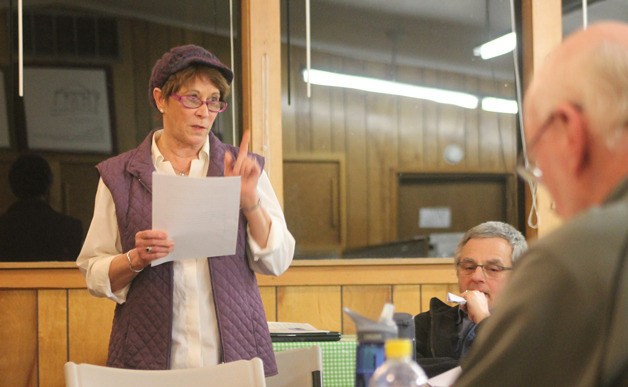A “dream” proposal to rename the Clinton Ferry Terminal fell flat with the volunteer-led, long-range planning group working to give Clinton a voice and an identity.
More than a dozen people Monday night listened to the Clinton Community Council discuss a private pitch to rename the facility and rebrand state ferries literature to highlight Whidbey Island, potentially at the expense of Clinton. Also drawing a lot of interest and chatter was the Port of South Whidbey’s market study.
Council President Jack Lynch suggested they adopt a formal opinion to relay to the state ferries department and the state Legislature. Among the council members, the ferry landing identification proposal drew a sharp rebuke.
“I think getting rid of ‘Clinton’ would negate everything we’ve been doing,” at-large council member Doug Hofius said.
The Clinton council has worked for the past few years to create an identity. It’s been a long slog, filled with long-range planning and vision meetings, the creation of the Clinton Town Picnic, and news of business closures and openings. The nine-member council, of which seven regularly participate, are trying to forge Clinton’s future for residents and businesses by creating a sense of place in the commercial hub near the ferry terminal.
Port Commissioner Curt Gordon, who also serves on the community council, agreed but said adding Whidbey Island to help identify Clinton’s location could be good. He would only support it if Clinton was the more prominent location, whether it was placed above or before or in a larger font.
“As long as Clinton is first,” he said.
Donna Hood, a Clinton resident, had proposed the idea and even lobbied State Rep. Norma Smith, R-Clinton, to seek such a change with the Legislature and Washington State Department of Transportation. As a longtime volunteer at the visitor kiosk on Highway 525 and Langley Road/Cultus Bay Road near Ken’s Korner, she said she hears from visitors asking where Clinton is. There’s also confusion about where Clinton is — on the peninsula, on Camano, on Whidbey — for first-time visitors, she claimed. Often she tells tourists they zipped past the community and should turn around to visit some of the shops or restaurants.
“I challenge you to be a tourist on Whidbey Island,” she said to the council.
Hood also said Clinton is thriving, but not in the traditional brick-and-mortar way. As someone who works with the lodging industry on Whidbey, she said she’s heard from plenty of people whose business is conducted — and booming — in virtual spaces.
“They’re doing business and they’re in their jammies,” she said.
She highlighted a few successful storefronts in the downtown Clinton area. Anthony Molinero said his studio creates a destination for a specific service and isn’t reliant on passing traffic, so Clinton has worked well for him. Lydia Christiansen, owner of Abundant Earth Fiber in Clinton, said her grand vision for her wool business was to expand and create a product identity for the area. She cited Harris Tweed as a model example. The tweed is all produced in an area of Scotland and highly sought after, she said.
Janae Cameron said she had asked Hood to not be included in the proposal she submitted to the Clinton Community Council, but went on to tout that her Highway 525 Clinton business has succeeded, as is. Most of her business in the past year was done in November and December and most of the customers came in after passing it several times. She and her commercial neighbors are working to create a small shopping center identity — Port Clinton — and already have a tagline, “Shop, Sit, Eat.”
That kind of commercial success is exactly what the Port of South Whidbey wants to emulate and be able to hone in on with its study of the area’s market potential. Gordon complained an earlier Record story about the consulting firm’s report of survey results was premature, but later said any feedback from people on South Whidbey was positive.
The port contracted with Beckwith Consulting Group to study market trends. That means they wanted to know where people from Clinton to Freeland shop, what they get and why. In December, the group conducted daylong focus groups with residents, business owners, commercial property owners, and government agency representatives to find out more about Clinton.
Online surveys are also ongoing at http://portofsouthwhidbey.com.
Results from the surveys have pointed to several trends so far, said Gordon, but they have not been released. Port district Executive Director Angi Mozer said about 350 surveys were completed so far. From those, Gordon said more people on South Whidbey are “unfortunately” willing to wait in line to get “what they want” at malls in Lynnwood and Seattle than stay on the island.
Lynch said more people may fill out the surveys if the results are published because it gives them something to which they can react and respond.
One of the most controversial pieces of Beckwith’s concept design was the installation of two roundabouts in Clinton on the highway. Traffic control has long been touted as a key to improving the sense of place and connecting Clinton by the community council. The highway sees regular high-speed traffic in 30-minute intervals because of the ferry. Crossing the highway isn’t a simple stroll, they say.
“You can’t have a racetrack zipping through it,” Gordon said.
Ideally, the roundabouts slow traffic without fully halting it. That gives people more time to cross the road and drivers more time to take in their surroundings.



